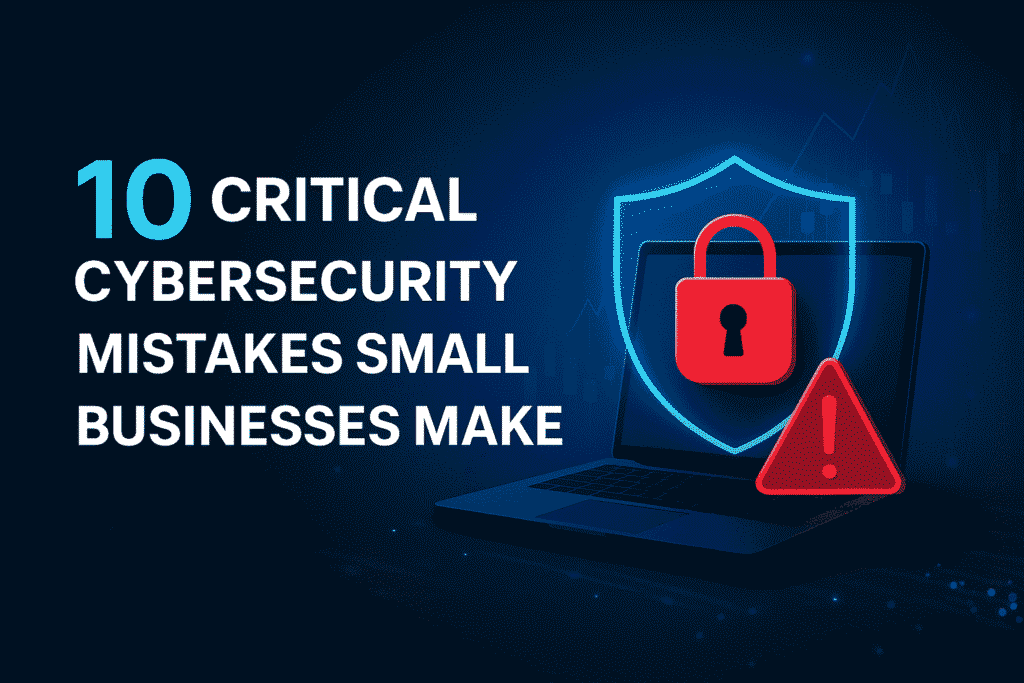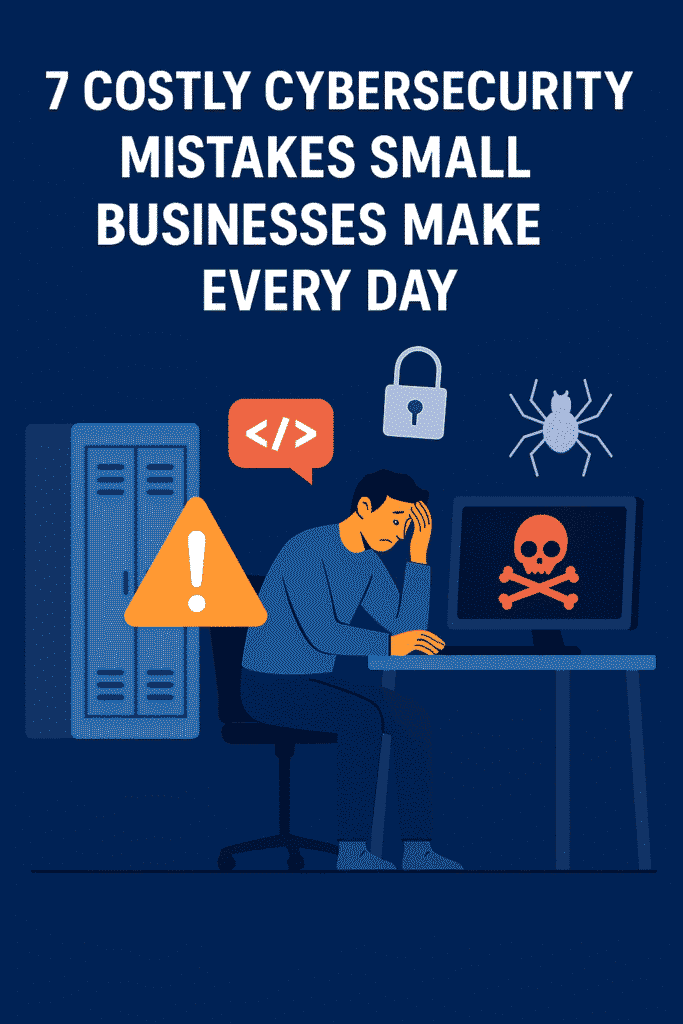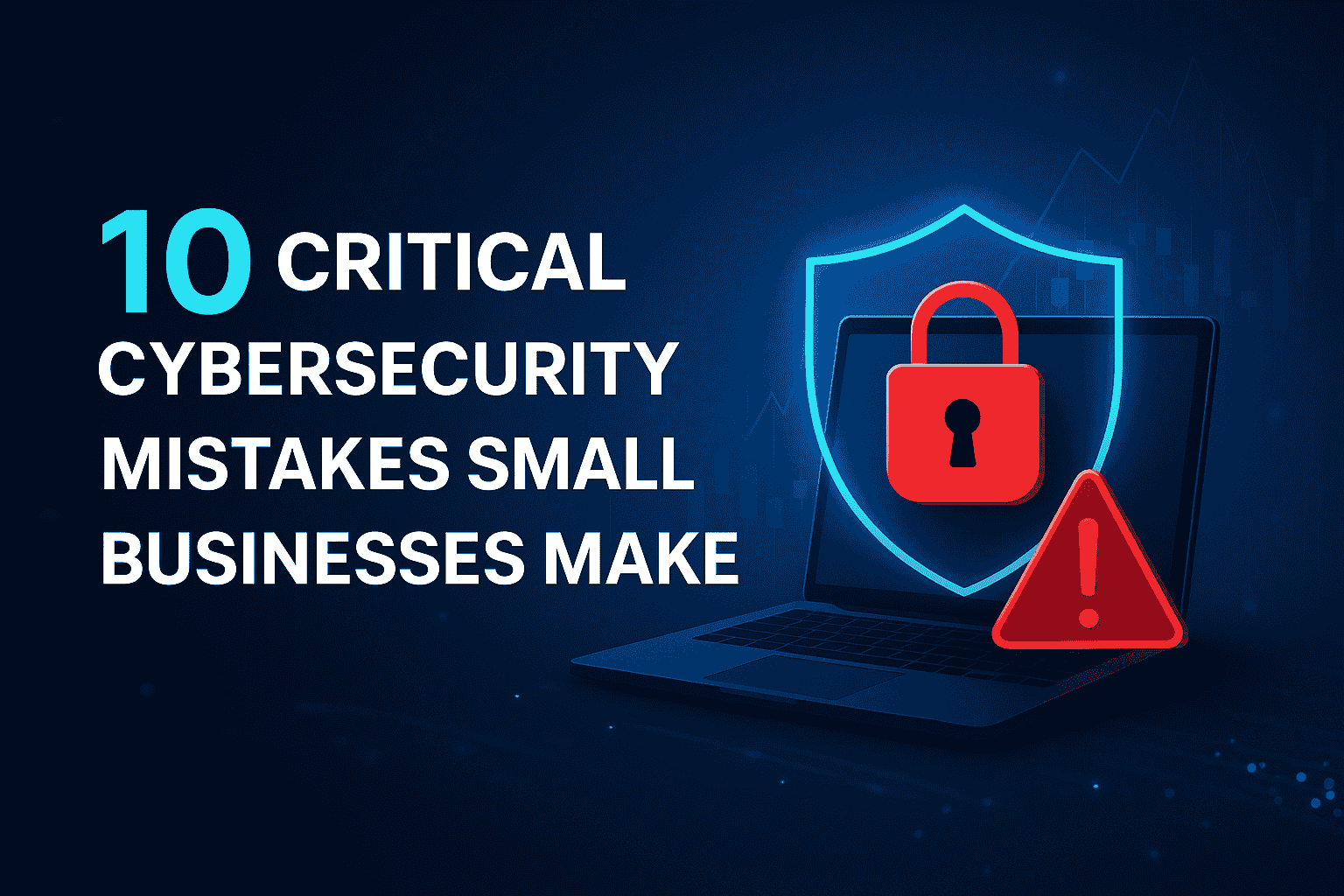Cybersecurity Mistakes Small Businesses Make Every Day

Introduction
Cybersecurity is no longer a “big corporation” concern. In 2025, cybersecurity mistakes small businesses make every day are costing owners millions — not just in financial losses but also in reputation and customer trust.
According to the IBM Security Data Breach Report, 43% of cyberattacks target small and medium-sized enterprises (SMEs), yet only 14% are prepared to defend themselves. This gap is a goldmine for hackers who exploit everyday mistakes that go unnoticed.
The truth is: Cybersecurity is not optional anymore. Small businesses store customer information, process online payments, and operate via cloud-based tools — making them just as vulnerable as global enterprises.
In this blog, we’ll explore the most common cybersecurity mistakes small businesses make every day, why they’re dangerous, and how to fix them before a breach happens.

1. Weak or Reused Passwords
One of the most damaging cybersecurity mistakes small businesses make every day is using weak, predictable, or reused passwords.
- Passwords like “123456,” “password,” or the business name are still shockingly common.
- Employees often reuse the same password across email, payment systems, and file storage.
Why this is dangerous:
A single compromised password can give hackers access to multiple systems, allowing them to steal data, lock accounts, and demand ransom.
How to fix it:
- Use a password manager like Bitwarden or LastPass to generate and store unique passwords.
- Enable multi-factor authentication (MFA) on all accounts.
2. Ignoring Software Updates
When small businesses delay updates, they leave their systems vulnerable to known exploits.
- Outdated CMS plugins (e.g., WordPress, Shopify apps) are a major attack vector.
- Operating systems without recent patches are easy targets.
Why this is dangerous:
Hackers actively scan for outdated software to exploit weaknesses.
How to fix it:
- Turn on automatic updates for operating systems, browsers, and plugins.
- Assign a team member to oversee patch management weekly.
3. Lack of Employee Cybersecurity Training
Your employees are your first line of defense — and often the weakest link. Many cybersecurity mistakes small businesses make every day happen because staff don’t know what to look for.
- Phishing emails mimic legitimate requests.
- Malicious links can infect a system with one click.
Why this is dangerous:
One click on a fake invoice can compromise your entire network.
How to fix it:
- Conduct quarterly cybersecurity awareness training.
- Simulate phishing attacks to keep employees alert. (KnowBe4 is a popular tool for this.)
4. No Data Backup Strategy
Cyberattacks aren’t the only reason data is lost — accidental deletion, hardware failures, and natural disasters happen, too.
- Without backups, ransomware attacks can force you to pay criminals.
- Cloud sync is not the same as a backup.
Why this is dangerous:
If your only copy of critical files is encrypted or deleted, recovery can be impossible.
How to fix it:
- Follow the 3-2-1 backup rule: 3 copies, 2 media types, 1 offsite/cloud.
- Regularly test your backup recovery process.
5. Using Public Wi-Fi Without Protection
Remote and hybrid work make public Wi-Fi a common convenience — but it’s a security nightmare.
- Hackers can use “man-in-the-middle” attacks to intercept data.
- Fake Wi-Fi networks can mimic legitimate ones to steal login details.
How to fix it:
- Always use a VPN (Virtual Private Network) when connecting to public Wi-Fi.
- Avoid accessing sensitive data from unsecured networks.
6. Ignoring Mobile Device Security
In the era of mobile business management, securing smartphones and tablets is critical.
- Lost or stolen devices can expose sensitive client and company data.
- Many businesses skip mobile encryption and device management.
How to fix it:
- Enable full-device encryption.
- Use mobile device management (MDM) tools to allow remote wiping if needed.
7. No Incident Response Plan
One of the most underestimated cybersecurity mistakes small businesses make every day is failing to plan for an attack.
- Many owners believe “it won’t happen to us” until it does.
- Without a plan, response times are slow, leading to bigger losses.
How to fix it:
- Draft a step-by-step incident response plan that includes:
- Who to contact first
- How to isolate affected systems
- How to communicate with customers and stakeholders
- Review and update the plan every 6 months.
8. Not Securing Third-Party Integrations
Small businesses rely on external tools — payment gateways, CRMs, marketing apps — but each integration is a possible vulnerability.
Why this is dangerous:
If a third-party vendor is hacked, your data could be compromised too.
How to fix it:
- Audit integrations quarterly.
- Remove unused apps and require vendor security compliance checks.
9. Overlooking Physical Security
Cybersecurity isn’t just digital — physical access to devices matters too.
- Unlocked office computers can be exploited.
- Lost USB drives with sensitive files pose a huge risk.
How to fix it:
- Use strong device passwords and auto-lock features.
- Store sensitive documents and hardware in secure locations.
10. Assuming Cybersecurity Is “Too Expensive”
Many small businesses believe that robust cybersecurity is only for large corporations.
- In reality, most breaches cost far more than preventive measures.
- Affordable tools like firewalls, endpoint protection, and MFA can block the majority of attacks.
Conclusion
The cybersecurity mistakes small businesses make every day aren’t always technical — often, they come down to habits, awareness, and priorities. The cost of prevention is far less than the cost of recovery.
At LogicNosh, we specialize in helping small businesses build affordable, custom cybersecurity solutions to keep their data, systems, and customers safe.
📞 Contact Us today to secure your business for 2025 and beyond.







